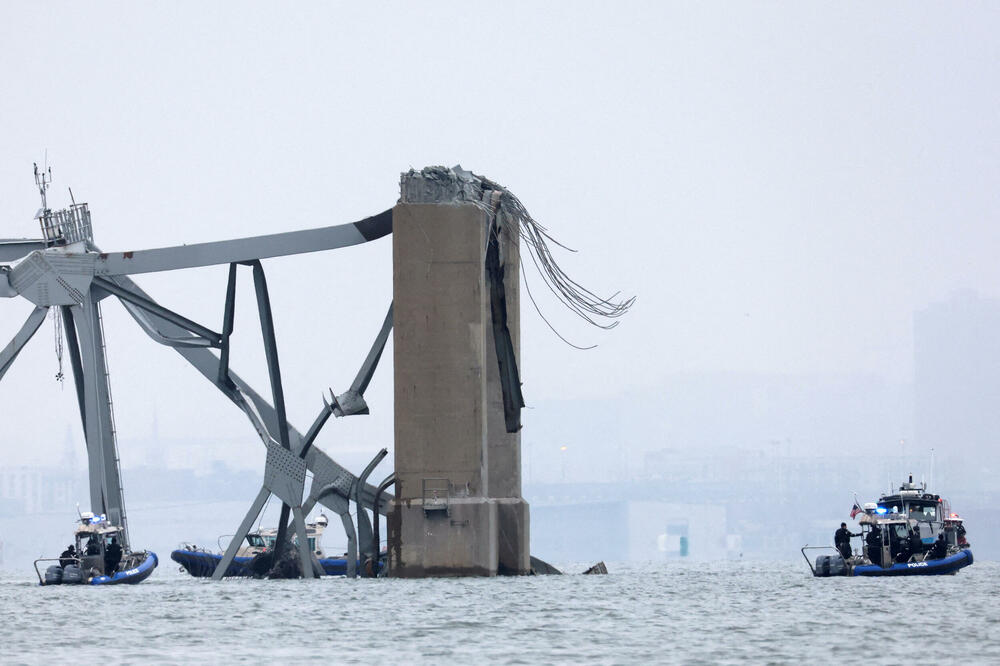Shortly after midnight on Tuesday, the freighter Daly struck one of the support piers of the Francis Scott Key Bridge, which spans Baltimore Harbor.
The 2,4-kilometer-long bridge immediately collapsed, and eight construction workers who were on it at the time fell into the water.
Two were rescued that day, the bodies of two more were found on Wednesday, and the search continues for the other four, who are presumed dead.
The accident closed a major US port, leading to fears of negative effects on global supply chains.
Investigators are looking into the cause of the accident, and the data recorder should provide more details about what caused the ship's problems.
However, experts say a number of factors, from possible poor fuel quality that would have caused power outages to the fact that the bridge was designed for much smaller ships, may have contributed to the bridge's collapse.
Bad fuel
The video of the incident shows Dali losing power in the moments before the crash.
The power outage may have caused the ship's crew to lose steering control, leaving them unable to control its trajectory.
Investigators are reportedly looking into whether contaminated fuel played a role in the ship's loss of power.
Bad, impure fuel can cause problems with marine engines and power generation.
"The vessel shut down, there was no steering gear and no electronics," the official told Fox News.
“One of the engines sputtered and then stopped. The smell of burnt fuel was everywhere in the engine room and it was pitch black."
When it lost power, the ship drifted uncontrollably toward the bridge.
The crew's efforts to mitigate the impact, including dropping the anchor, proved unsuccessful.
“This is a huge ship. And the momentum and energy of such a ship moving at a minimum speed of only a few kilometers per hour is enormous," said Sanjay Raja Arvade, professor of civil engineering at the University of Massachusetts Amherst.
At a news conference on Tuesday, Transport Minister Pete Battigieg said the bridge was "simply not built to withstand a direct impact from a 90,7 million kilogram ship into the support column".
Watch the video: The moment the ship hits the bridge in Baltimore
A bridge from the last century, a ship from this one
The Francis Scott Key Bridge was completed in 1977.
At that time, the vessels they had to pass under were much smaller than today's giants, including the monstrous Dali.
"The ships that used to come in and out of Baltimore Harbor and the ships of today don't even compare," says Norma Jean Mattei, former president of the American Society of Civil Engineers.
"The lifespan of a bridge is sometimes more than 100 years, and the design and construction time is difficult to predict," he adds.
Civil engineers often think about designing structures so that one part can fail, but the whole structure does not collapse, Professor Arvad said.
But designing 'surplus' in the piers holding up long bridges would be "extremely difficult to impossible".
He added that other safety features, which could have helped, come at a cost and would be of limited effectiveness.
Experts said it appeared that 'dolphins' - protective barriers - were placed near the Francis Scott Key Bridge, but did not prevent the ship from collapsing the bridge.
It also appears that the bridge did not have 'dams' - an extra layer of protection around the bridge pier - that could have absorbed some of the impact.
The authorities may have judged that the probability of a massive ship hitting one of the bridge's support columns was too low to justify the investment in strengthening them.
"We have limited budgets," says Matei.
David Knight of the Institute of Civil Engineers said that after the collapse, those managing bridges around the world will be assessing how to ensure a similar disaster does not happen again.
"Lessons will be learned and they will help us design and build even safer bridges," he said.
Follow us on Facebook,Twitter i Viber. If you have a topic proposal for us, contact us at bbcnasrpskom@bbc.co.uk
Bonus video:




